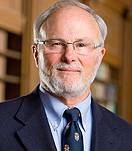News
UB 2020 in jeopardy without reforms, Simpson tells FSEC
-
 Print
Print -
 Comments
Comments
-

“Given what’s been taken out of this university…I’m worried about our status as a research university, our ability to do the things that we do.”
President John B. Simpson told the Faculty Senate Executive Committee yesterday that the future of UB 2020 hinges on the passage of the Public Higher Education Empowerment and Innovation Act (PHEEIA), a package of reforms that include what he has called a predictable, differential tuition plan that keeps tuition dollars at UB instead of sending them to the state.
His impassioned presentation to the FSEC highlighted many of the same themes he covered at a news conference earlier in the week at UB’s New York State Center of Excellence in Bioinformatics and Life Sciences on the university’s Downtown Campus. With UB anticipating another $16.5 million cut to state funding, Simpson told the FSEC, the Western New York community and state leaders need to take action.
“If we continue what I described as ‘business as usual’ in New York, then two things are going to happen,” Simpson said. “One, UB 2020 is very, very likely simply not going to happen. It’s not going to happen in any way, shape or form that we envisioned as a university.”
Secondly, Simpson said, “Given what’s been taken out of this university...I’m worried about our status as a research university, our ability to do the things that we do.”
One of the most important reforms in PHEEIA is a policy that would ensure that money from tuition increases goes to the institutions that students are attending, instead of going to plug holes in the state budget. PHEEIA also would empower the SUNY Board of Trustees to charge differential tuition for programs and campuses within the system and give universities discretion to raise tuition at a rate tied to the Higher Education Price Index, an inflation index for costs associated with higher education.
While people assume that tuition will remain largely flat if lawmakers regulate it, “Over the last 20 years, on average, the legislature—your legislature—has increased tuition at SUNY an average of 7 percent,” Simpson said. “That’s astonishing when you think about it.”
The timing of past hikes has been “destructive,” Simpson added, with many coming during periods of economic hardship as the state struggled to pay its bills. Supporters say PHEEIA would make it easier for families to plan for college. Simpson said he hopes, in the future, to be able to tell entering students what their fees and tuition will be for the next four years. He added that a significant percentage of revenues from tuition increases would go toward providing need-based financial aid, another measure that would help ensure access to UB.
With so much at stake, Simpson encouraged faculty leaders who attended yesterday’s meeting to share their thoughts on PHEEIA with legislators, including those from Western New York and those occupying positions—such as the chairmanships of the Assembly and Senate Higher Education committees—that carry statewide responsibilities.
Also at the meeting, the FSEC was scheduled to but did not vote on approving the Faculty Senate Affirmative Action Committee Handbook on Recruitment and Retention, which is intended to assist search committees, departments and decanal areas in building and maintaining a diverse faculty to foster a diverse and well-educated student body. Executive committee members are expected to vote, by e-mail, on approving the document before their next meeting, which will not take place until April 21.

Reader Comments